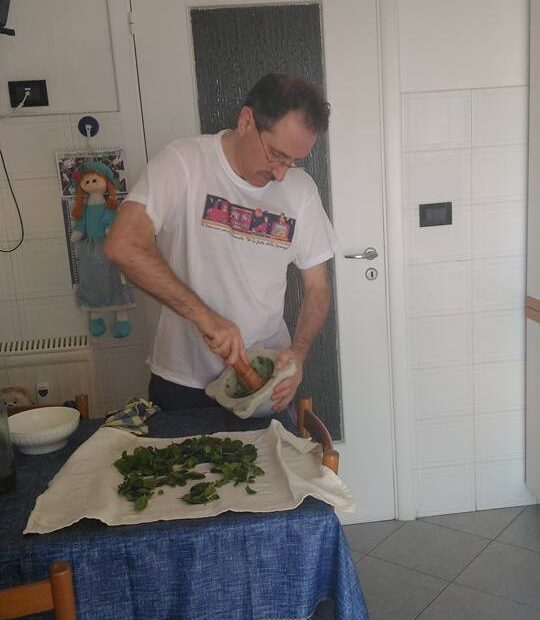By popular demand, here is to you the definitive guide for non-Genoese who wish to venture into a really challenging path: everything you absolutely need to know about pesto, why it is a religious topic for the Genoese people and how to make it and then taste it properly. Are you ready?
- DifficultyDifficult
- CostMedium
- Cooking methodNo cooking
- CuisineItalian
- SeasonalityEvergreen
Thou shalt have no other pestos before it!
First and foremost, put back on the shelf that jar filled up by whatever greenish stuff but pesto, smile and leave the supermarket. Be serious and go get a mortar! No, not that kind of bowl you would use for mojito, but a real, large marble mortar, with a wooden pestle. Better if worn-out, a grandmother’s heritage, otherwise go buy new ones.
Second step: the basil has to be very fresh and from Liguria, far better if from Genoa, absolutely perfect if from Pra’. Other basil is allowed only if a real Genoese guy sais to you: “Ok, I’m keeping an eye closed.” Why? Kindly take note: far from Genoa, basil is only a common, decorative little plant. In the basil we are talking about, there is all the Genovesity that makes pesto something uncommon, not to mention superb. That is, there is a thin strip of land, compressed between mountains and sea and therefore difficult to cultivate, which offers very little; but that little it returns, it summarizes in itself all the salty of the sea, the warmth of the sun and the harsh wild nature of such a particular Mediterranean place. Nevertheless, there are people just as salty, gruff and silent, but who carry within themselves that human warmth typical of seafarers, which gradually opens up like clams and inebriates you with all its flavor.
Ingredients
Basil, as mentioned above
Coarse salt
Garlic cloves
Shelled pine nuts (the best are those of Versilia, Italy)
Extra virgin olive oil (the best quality, Ligurian D.O.P. at least)
Parmigiano-Reggiano in powder (this one, not another cheese!)
Sardinian pecorino in powder
Steps
1. Collect the basil leaves, wash them as a salad is commonly washed (in a container of water with coarse salt), then dry them and let them rest in a linen cloth
2. Take a few cloves of garlic, remove the skin (of course!), open them one by one and remove their intern core. You will thank me for that.
3. Put the garlic, a handful of pine nuts and a little coarse salt in the mortar and start pounding with the wooden pestle until you get a pasty substance.
4. At this point, add a handful of basil. Pound and mix until everything is reduced to a homogeneous mush, adding from time to time a splash of olive oil, one of Parmesan and one of pecorino. The same operation must be repeated several times until the basil runs out, without ever extracting the contents from the mortar. The content should be tasted from time to time to evaluate the consistency and quality (sometimes it will be necessary to add salt, other parmesan and pecorino: deciding when and how much it will depend on your experience level).
5. Consume the pesto if possible as soon as it is ready, adding a little cooking water in the mortar, mixing and then seasoning your trofie or trenette just poured on the plate.
Useful tips
Never use steel utensils or other ingredients: the flavor would change significantly!
Use the pestle methodically and regularly, without tearing. Don’t be quick, don’t be in a hurry. Start the movement from the arm to the palm of the hand and pound more or less as if you were digging and cleaning the bottom of a pot: light strokes in depth, then on the sides, then to mix everything.
If you want to make a Genoese happy, tell him that you cooked the trofie with potatoes and green beans and then made them with pesto. If you want a Genoese doubly happy, allow him/her to make “puccetta” when finished eating: in other words, let him/her dip bits of bread in the plate and then in the mortar until they are both as cleaned and dried as new.
Varied doses for servings













The real pesto genovese !!! 😋😋😋👏👏👏
definitely! 🙂
Fantastic! The useful tips make it extra authentic 👌
Glad you noted and appreciated them! Thank you so much 🙂
Recipe for making real genoese pesto written with particular and exciting commitment. The marble mortar and wooden pestle seem to come alive in this explanation.
Happy you enjoyed it! Thank you a lot for your kind words!